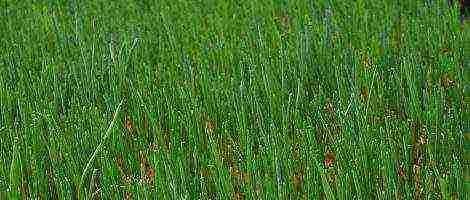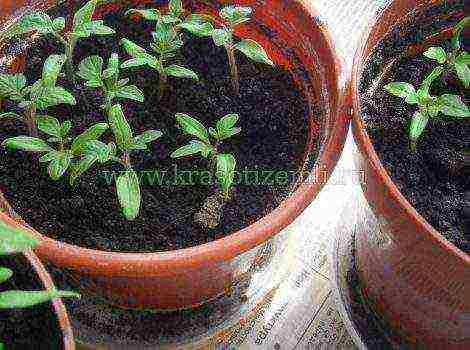Content
- 1 Seedlings of cucumbers: to plant or not?
- 2 How to sow cucumbers in a greenhouse
- 3 Where is it better to grow cucumbers: a greenhouse or a greenhouse?
- 4 How to form cucumbers in a greenhouse: hybrids and varieties
- 5 Growing cucumbers in a greenhouse
- 6 Care for cucumbers in the greenhouse
- 7 Harvesting
- 8 Diseases of cucumbers
- 9 Growing cucumbers in a greenhouse
- 10 Benefits of growing cucumbers in a greenhouse
- 11 Cons of growing cucumbers in a greenhouse
- 12 Benefits of growing cucumbers on a steam bed
- 13 Cons of growing cucumbers on a steam bed
- 14 Pros and cons of growing cucumbers in a greenhouse
- 15 Seed selection
- 16 What varieties can be planted
- 17 Greenhouse preparation
- 18 Landing
- 19 Care
- 20 Top dressing
- 21 Formation
Content:
- Seedlings of cucumbers: to plant or not?
- How to sow cucumbers in a greenhouse
- Where is it better to grow cucumbers: a greenhouse or a greenhouse?
- How to form cucumbers in a greenhouse: hybrids and varieties
It seems that recently we discussed growing tomato seedlings, and now it's time to sow cucumbers. The opinions of gardeners differ here: someone prefers to grow seedlings at home and only then transplant the cucumbers into a greenhouse, for others it is more convenient to sow seeds in a greenhouse or greenhouse right away. We tell you when to plant cucumber seedlings, how to create good conditions for it in a greenhouse or make a greenhouse with your own hands.

Back to content
Seedlings of cucumbers: to plant or not?
There is no point in growing cucumbers through seedlings at home. The gain is only 7–10 days, and you will not get around the hassle, because pumpkin plants have a weak and poorly regenerated root system. Sucking hairs break off even when the soil is loosened, and not just when they are transplanted.
Transplanting for pumpkin seeds is a lot of stress, since the cut off sucking hairs on the old root are not restored. First, a new root should grow, and then become hairy and start pumping the soil solution into the leaves. During this time (about a week), part of the leaves will die, the plant will weaken and take root badly in a new place.
In general, you will lose about 10 days on this operation. During this time, the seeds sown in the ground will have time to ascend and immediately move into growth. They are much stronger and more hardy, as they immediately grew on the spot than sissies grown in indoor conditions.
But if you really want to eat cucumbers and zucchini a week earlier than all your neighbors, then transplant them into a greenhouse at the age of 25 days, when they have only one real leaf. Then the root system of a cucumber or zucchini has just begun to form, so that it will transfer the transplant with minimal losses. And best of all, cucumbers and all pumpkin crops tolerate transplantation in general with cotyledonous leaves.
In order for the root system to experience minimal stress, pumpkin seedlings should be grown in containers without a bottom. The easiest way to do this is to roll up newspaper cylinders wrapped in several layers around the bottle, fill them with soil and wear rubber bands to keep them from falling apart, or cut the top and bottom of plastic 300g yogurt bottles.
When transplanting newspaper cylinders, you do not need to unfold them (just remove the rubber band), the roots will easily grow through the sodden walls (do not be afraid, their strength will be enough for 25 days while you grow seedlings). Plastic cups must be carefully pulled down from the seedlings and planted, holding a lump of earth with your hand from below.
Gently squeeze the planted cucumber seedlings with soil, just as carefully pour with warm water and cover directly over the leaves with two layers of lutrasil. But if you have slugs, then it is better to immediately cover the planted plants with screwed 5-6-liter water bottles with a cut bottom.To prevent the slugs from crawling inside, press the bottom of the bottles from the sides, and cover the top with lutrasil.
Do I need to preheat cucumber seeds? If you are growing hybrids (such packages have an F1 sign), then do not, since they have a predominantly female flowering type. If you are growing varieties, and your seeds are fresh, then it is recommended to warm up to stimulate the rapid appearance of female flowers, since male flowers predominantly grow on the main stem of the varieties. It is done this way: just before planting, warm the seeds in a thermos with hot (53 degrees) water for 15–20 minutes - at the same time free the seeds from bacteriosis and anthracnose pathogens.
Back to content
How to sow cucumbers in a greenhouse
Since I do not like any unnecessary work on the site, I sow dry cucumber seeds right in the greenhouse near St. Petersburg. I usually stick 2-3 seeds into one nest at a distance of about 4 cm from each other, with an edge into the soil and immediately cover the soil, first with a film, and then on top with two layers of lutrasil.
Before planting, you should dig trenches to the depth and width of a shovel bayonet, add dry hay or leaves, or not rotted compost into them. Return the soil removed from the trench to the hay, place a board on top and walk on it to compact the earth. Water the soil well and cover with black plastic to warm up the soil. After a week, the soil will warm up, the hay will begin to rot and generate heat. You can sow cucumbers.
Usually I do sowing in early May on such a warmed soil and, as always, before sowing, I spill the soil with hot water. Seedlings usually appear in seven days. After that, I remove the film so that the shoots do not burn out under the strong sun, and I leave the double lutrasil lying right on the shoots. With such a shelter, cucumbers in a greenhouse can withstand frosts from the outside to minus 5-6 degrees.
When 1-2 true leaves appear on the cucumbers, I carefully plant the extra leaves from each nest and usually distribute them to neighbors. The fact is that the current seeds have a disgusting germination, and therefore often one plant emerges from 2-3 sown seeds.
Back to content
Where is it better to grow cucumbers: a greenhouse or a greenhouse?
If you have a high greenhouse, then the air in it is very cooled at night, since the heat from the soil heated during the day rises and is not enough to heat such a large volume of air. Cucumbers do not like cold snaps at night, besides, greens grow at night, so on cool nights you need to turn on heating: it can be electric or kerosene lamps, tape heaters and other devices.
Therefore, in regions with cold summers, it is better to grow cucumbers not in tall greenhouses on a vertical trellis, but horizontally in small greenhouses, because the warm air that rises from the soil at night may well keep the heat in a small volume.
In particular, in the North-West, cucumbers do not grow in open ground, they have to be grown on a covering ground, that is, the ridges with cucumbers should be covered at night and opened during the day. It is convenient to do this if arcs, metal or from willow twigs, are installed over the beds with cucumbers. It is necessary to immediately remove the bark from the cut rods (at this time it is removed very easily), bend the rods in arcs, sticking it into the soil. Such willow arches last 5–6 years if they are removed from the soil for the winter, tied in bunches and kept under a roof so as not to get wet.
Cucumbers love moist soil, but that doesn't mean they should be over-watered. The soil should be constantly moderately moist, without turning into slush. This can be achieved in different ways, for example, by organizing drip irrigation using hoses with holes.

Back to content
How to form cucumbers in a greenhouse: hybrids and varieties
If you are growing cucumbers on a vertical trellis in a tall greenhouse, they must be tied up.Tie a loose loop under the first real leaf and, twisting the stem counterclockwise with the cord, pass it under each leaf. Pull the cord and tie it with a bow to a horizontal wire 1.5 meters above the ground. Further, if the cucumbers themselves do not cling to the cord, wind the cord around the stem yourself.
When the cucumbers have grown to a horizontal wire, throw them over the wire and make them grow downward by tying the growing end of the stem to its own lower part.
If you grow cucumbers vertically, then their formation is reduced to the fact that you need to blind (pluck out what grows from the leaf axils) 3-4 lower leaves. This is done so that the lowest lashes do not grow - they take all the nutrients first, but almost do not bear fruit due to lack of light. In addition, they thicken the lower part of the plants and, due to poor ventilation, stem rot often begins in the lower part of the plants.
Then, as the cucumbers grow, it is necessary to pinch the side shoots, breaking off the end of the shoot as soon as 2 leaves are formed on it. Then the greenhouse will not thicken, all plants will have good access to light and air. If this is not done, a continuous jungle of stems and leaves will form, among which cucumbers will only appear in some places. With thickening of plantings, the yield of cucumbers drops sharply.
As soon as you put the cucumber stalks over the horizontal trellis (wire), stop pinching the side shoots. Their ends will branch, and on these branches the fruiting will be in clusters, that is, several cucumbers from one place.
Nowadays, varieties and hybrids of single-stemmed cucumbers have been created, which either have no side shoots at all, or they are greatly shortened. Naturally, such cucumbers do not require any formation. Their growth is usually limited - they end in a flower or a bunch of flowers. Their yield is formed only on the main stem, so their yield is lower, but they can be planted denser, up to 10 plants per square meter, so the total yield from the greenhouse area is the same.
If you grow cucumbers in a greenhouse in a horizontal position, then you do not need to form them either.
Do I need to pinch cucumbers after the 4th leaf? If these are hybrids (denoted by the F1 label), then it is not necessary, since they immediately have female flowers on the main stem, which have a small cucumber.
If it is a variety, then it has mainly male flowers on the main stem. Female flowers are usually formed on lateral shoots.
To accelerate the appearance of lateral shoots with female flowers, the crown with the upper growing point is cut off, and then the bud closest to the growing point gives a lateral shoot. This first lateral shoot will later replace the dangling central stem. Usually it is recommended to break off the crown (pinch) over the 4th leaf of the main stem.
x
Did you like the article?
Rate the article
Discussion
I don’t know how stressful there is during the transplant ... If the arms grow from where, no stress. I always transplant cucumbers and zucchini, as a rule, without problems.
.
Comment on the article "Growing cucumbers: when to sow seedlings for the greenhouse and greenhouse"
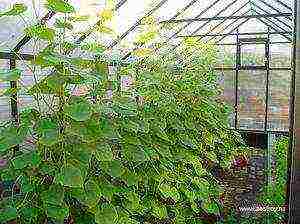 Cucumber is one of the healthiest and earliest vegetables. If you eat cucumbers every day, then the human body is cleansed of harmful substances, toxins and toxins. It also perfectly satisfies hunger, since cucumbers are composed of water, which contains various minerals. It is the water that stretches the stomach and creates a feeling of fullness. It is impossible to recover from cucumbers, since their calorie content is not more than 15 kcal per 100 g of vegetable. It can be very difficult to grow it without greenhouse conditions. Planting cucumbers in a greenhouse or in a greenhouse takes little time, cultivation does not take much time and much effort. At the same time, you can get a huge harvest of such a useful vegetable.
Cucumber is one of the healthiest and earliest vegetables. If you eat cucumbers every day, then the human body is cleansed of harmful substances, toxins and toxins. It also perfectly satisfies hunger, since cucumbers are composed of water, which contains various minerals. It is the water that stretches the stomach and creates a feeling of fullness. It is impossible to recover from cucumbers, since their calorie content is not more than 15 kcal per 100 g of vegetable. It can be very difficult to grow it without greenhouse conditions. Planting cucumbers in a greenhouse or in a greenhouse takes little time, cultivation does not take much time and much effort. At the same time, you can get a huge harvest of such a useful vegetable.
Growing cucumbers in a greenhouse
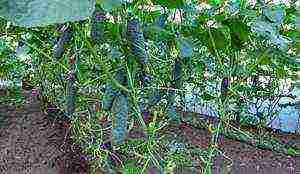
In order for a cucumber to grow in greenhouse conditions and give a good harvest, it is necessary:
- choose a variety of cucumbers that is grown in greenhouses;
- create favorable conditions for its growth;
- prepare the soil and fertilizers;
- decide on the method of pollination of flowers.
Greenhouse location
The greenhouse must be placed in such a place that the north and north-east winds do not affect it, and a hedge must also be built. Desirable so that the soil in this place is fertile... The optimal greenhouse area is 2: 1. It is this size of the greenhouse that does not depend on changes in temperature outside. For covering, it is better to use a transparent film, since the sun's rays penetrate well through it and it does not allow moisture to pass from the street. If the cucumbers are grown in winter, then the greenhouse is made from other materials at hand.
In the fall, it is necessary to prepare a place for the future greenhouse. It is necessary to disinfect the wooden parts of the greenhouse with a solution of copper sulfate, metal parts must be painted. Remove 3-4 cm of the topsoil. Apply special fertilizers to the soil, such as: non-rotten manure 20-25 kg per 1 square meter, lime 200 g, potash and phosphorus fertilizers 50 g. After that, you need to dig up the ground. If the land is prepared in the spring, then it is necessary to add special fat-free manure to the groundto avoid various infections. According to agronomists, the best soil for cucumbers is:
- field soil - 20% (it is disinfected with a solution of copper sulfate 7%);
- humus - 30%;
- peat - 50%;
- sawdust of trees.
Planting cucumbers in the greenhouse
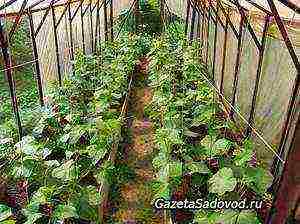 The beds in the greenhouse are made 20 cm high, the seedlings are planted 30 cm apart. If you plant it thicker, then the plant will get less light than it needs. At a height of 2 m, a rope is pulled over the rows so that the plants can trail.
The beds in the greenhouse are made 20 cm high, the seedlings are planted 30 cm apart. If you plant it thicker, then the plant will get less light than it needs. At a height of 2 m, a rope is pulled over the rows so that the plants can trail.
Cucumbers germinate in 5 days at a temperature in the greenhouse of 30 degrees, if the temperature is not higher than 12 degrees, then the plants will not germinate. The most the optimal temperature is 20 degrees, with her, cucumbers germinate in 20 - 25 days.
Care for cucumbers in the greenhouse
How to grow cucumbers in a greenhouse? Caring for cucumbers in a greenhouse is that it is necessary to form a bush, tie up, water, feed, pinch off and pollinate, if necessary. A cucumber grows with one stem. After about 5 days, it is necessary to tie up the plant so that it does not spread on the ground and break. Branching is limited by plucking: the upper part of the stem is torn off when it outgrows the rope stretched over the rows. 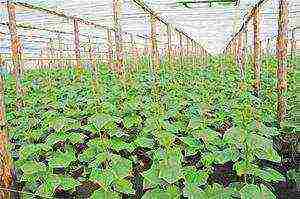
Also, if desired, pinch off the side shoots and flowers. In the middle part of the sprout, pinch off the lateral shoots above the first leaf, and at the top of the sprout - above the second leaf. The tendrils, yellowed leaves, shoots from which the harvest has already been harvested are also removed.
Greenhouse cucumbers must be of a specific type. When choosing a variety of cucumbers, special attention should be paid to how they are pollinated. If a vegetable is pollinated by bees, then it is necessary to make sure that the bee gets into the greenhouse without any problems... It is also necessary to feed the bee with sugar syrup, which is infused with male flowers.
Top dressing for cucumbers
Greenhouse-grown cucumbers are fed several times as they grow. Must be fed at the beginning of flowering with such a mixture: 1 glass of chicken manure and 1 glass of nitrophoska are diluted in 10 liters of water. After 10 days, a special solution should be made, which must be poured into the hole. The solution consists of water and manure. You can also use top dressing such as:
- Breadwinner;
- Ideal;
- Giant.
You can also take the grass and fill it with hot water, let it brew for a couple of acres, add the resulting mixture.
Further feeding depends on the appearance of the plant, but it is recommended to feed it no more than 5 times before the fruits ripen. Fertilizers that are used for pumpkin are very well suited for cucumbers.It is very difficult to determine what kind of fertilizer the plant lacks. There are some changes in leaves and shoots that allow you to see what and how to fertilize.
Sandy soil must be fertilized with nitrogen fertilizers. But at the same time, it should be borne in mind that if the plant is dark green, the stems and leaves grow quickly, the flowers are not tied. All this indicates an excess of nitrogen in the earth. This can occur if there is a lot of fresh manure in the ground. Nitrogen deficiency is indicated by pale, sluggish leaves that turn yellow and fall off. Lack of phosphorus is usually visible on small leaves of dark green color with a bluish tint, the shoots stop growing. Cucumbers have the same symptoms when they are supercooled or watered heavily.
The appearance of deformed fruits and leaf fall is caused by a lack of potassium. With a lack of magnesium, the leaf turns yellow, and the veins remain green.
An insufficient amount of minerals in the ground leads to the slowing down of stem growth, poor flower development, and a significant reduction in the volume of cucumber harvest.
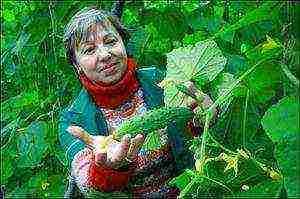 Cucumber absorbs liquid fertilizers best, so all fertilizers must be diluted with water... There are many mineral fertilizers that are sold in tablets. Including manure, dilute with water, let it stand for a couple of days and mix it from time to time. You can use manure from poultry, cows and other animals. 1 kg of poultry manure should be diluted in 20 liters of water, other types of manure can be diluted in a ratio of 1 kg of manure to 5 liters of water. It should be noted that in large greenhouses, plants are not fertilized with manure, because the soil may be contaminated with bacteria that are in it.
Cucumber absorbs liquid fertilizers best, so all fertilizers must be diluted with water... There are many mineral fertilizers that are sold in tablets. Including manure, dilute with water, let it stand for a couple of days and mix it from time to time. You can use manure from poultry, cows and other animals. 1 kg of poultry manure should be diluted in 20 liters of water, other types of manure can be diluted in a ratio of 1 kg of manure to 5 liters of water. It should be noted that in large greenhouses, plants are not fertilized with manure, because the soil may be contaminated with bacteria that are in it.
Top dressing should be carried out in cloudy weather in the first half of the day, and in sunny weather - in the late afternoon. It is advisable that a container with manure and water stand inside the greenhouse. During the decay of manure, oxygen is released, which is favorable for growing cucumbers.
Watering cucumbers
When planting, cucumbers should only be watered with warm water. In cold weather, it is better to water in the morning in sunny weather. In the warm season, plants should be watered 2 times a day or once in the evening and very abundantly, since cucumbers grow most of all at night. The earth needs to be loosened so that oxygen penetrates better to the roots and so that they do not fester.
In warm weather it is necessary to open the greenhouse every day so that the plants are enriched with oxygen... The ground must be constantly moist, as cucumbers are very fond of water, they themselves are almost 90% water. You need to put a spray on the watering can so as not to damage the plant through the ground, because the roots are very close to the surface. In order to increase the yield of cucumbers, you can sometimes dry the ground.
Harvesting
Initially, when cucumbers produce only the first fruits, they need to be picked in the morning. In the future, you need to collect a couple of times a day, as they grow very quickly. If the crop is not harvested on time, the overgrown fruits will contribute to a decrease in the overall harvest. It is also necessary to remove ugly and damaged ovaries in a timely manner.
Diseases of cucumbers
The most dangerous disease when planting cucumbers is powdery mildew. The leaves of plants are covered with a specific bloom, dry up and fall off. With this disease, the plant completely disappears. You can save the plant if sprinkle the leaves with a solution of potassium permanganate or sprinkle with sulfur... It is necessary to treat the plant in warm sunny weather.
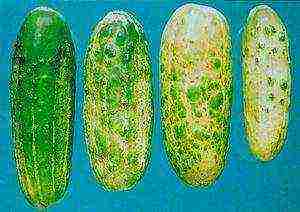 Mealy disease appears as oily spots on the leaves. Then the leaves turn yellow and fall off. At the first sign of such a disease, you need to stop feeding and pouring on the plant. Treat with a special solution that is used for powdery mealy disease. The greenhouse needs to be ventilated more often and the temperature should not be allowed to drop. up to 18 degrees Celsius.
Mealy disease appears as oily spots on the leaves. Then the leaves turn yellow and fall off. At the first sign of such a disease, you need to stop feeding and pouring on the plant. Treat with a special solution that is used for powdery mealy disease. The greenhouse needs to be ventilated more often and the temperature should not be allowed to drop. up to 18 degrees Celsius.
Insects such as ants, aphids, and ticks can also greatly harm cucumbers.For their extermination, special preparations are used.
If you correctly follow all the instructions necessary for growing cucumbers, then in the future you can get large volumes of the crop.
Growing cucumbers in a greenhouse
Cucumbers are very often grown in greenhouses. A greenhouse is a small film shelter for growing plants. Seeds or seedlings of cucumbers are usually planted in a greenhouse in mid-May. It is necessary to take care of the plants in the same way if they grew in an open bed in the ground. When planting cucumbers most often they use manure beds, with the addition of lime... Fertile soil or peat mixed with sawdust is poured into the holes, mineral fertilizers are also added to the ground.
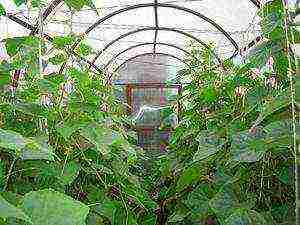 It is known that peat and sawdust make the soil more acidic. Lime and ash, on the other hand, reduce acid. After adding the necessary elements to the ground, the seedlings are planted in the holes. A transparent film is pulled from above. If frost is expected, then it is necessary to put the film in several layers.
It is known that peat and sawdust make the soil more acidic. Lime and ash, on the other hand, reduce acid. After adding the necessary elements to the ground, the seedlings are planted in the holes. A transparent film is pulled from above. If frost is expected, then it is necessary to put the film in several layers.
At night, so that the cucumbers do not freeze, the greenhouse must be covered with unnecessary rags or straw, paper or cotton mats. During the day, it is necessary to remove additional insulation. The frame of the greenhouse must be opened during the day.to supply oxygen. For good growth of cucumbers, it is necessary that the air temperature is 30 degrees Celsius in sunny weather, 25 degrees Celsius in cloudy weather, 22 degrees at night, 22-25 degrees Celsius should be the temperature of the soil.
The air temperature inside the greenhouse in the daytime is regulated by opening and closing the frame, and at night - with the help of special heaters. The temperature of the earth is regulated with the help of manure fertilizers, since manure generates heat during decomposition.
When growing cucumbers it is necessary to water them abundantly, with water at room temperature, especially when fruit appears. Greenhouse cucumbers are usually harvested after 2 days.
All summer residents want to grow delicious crispy, elongated vegetables - cucumbers. It would seem that there is nothing easier to plant seedlings in the ground and water them - the harvest is still provided. However, all this is only in dreams. In fact, many issues have to be resolved with this slightly finicky heat-loving culture. Let's try to figure out where it is better to grow cucumbers: in a greenhouse or on a steam bed.
Cucumber whips in a polycarbonate greenhouse
Benefits of growing cucumbers in a greenhouse
In greenhouse, more favorable conditions, if proper care of cucumbers is carried out, according to the site, in the greenhouse, they develop much faster. Already 1 month after planting cucumber seedlings, the first fruits begin to appear. The fruiting period in a greenhouse can be on the order of 2-3 months.
Growing such a delicate crop in a greenhouse makes it possible to receive a continuous collection of cucumbers until late autumn, in general, from 12 to 22 kg of culture from only one greenhouse section.
At the very beginning, after planting, the seedlings occupy a small area, therefore, earlier ripening crops should be planted nearby: onions on a feather, lettuce, radishes and others, which have time to yield a harvest by the time the cucumber lashes grow strongly.
Cons of growing cucumbers in a greenhouse
A good greenhouse with ventilation and protection from aggressive sunlight is needed. Also, it should have enough height space for stretching and growing cucumber lashes.
Cucumbers are quite demanding on water and need constant irrigation. To do this, you should think in advance about installing an automatic irrigation system.
The development of fungal diseases in the greenhouse occurs more rapidly and unexpectedly due to the fact that the space of a closed room needs constant ventilation. It is necessary to periodically apply special fungicidal preparations to prevent the multiplication of fungal spores.
It is necessary to ensure the constant collection of fruits every other day, and, at the same time with good specimens, it is required to remove the wrong underdeveloped ones.
The steam bed looks great in many ways.
Benefits of growing cucumbers on a steam bed
The steam bed is a good source of fertilizer and micronutrients. Also, manure in the process of decay emits a sufficient amount of heat, which is allowed to tolerate low temperatures in the evening without problems.
Since the garden bed is at a level of 40-50 cm from the ground, it is much more convenient to harvest from it.
Compared to cucumbers grown on the ground, lashes in the beds develop faster and yield earlier crops.
Read about micronutrient deficiencies in cucumbers
Cons of growing cucumbers on a steam bed
Fresh cow dung is required, which currently costs a lot of money. It is also necessary to lay out a ridge and cut holes in it. You also need to prepare the ground in order to fill it in the holes. It takes a certain amount of skill and time.
Caring for cucumbers in a greenhouse consists in keeping the soil free from weeds and in a loose state, protecting cucumbers from pests and diseases, and removing old and dying leaves from their greenhouses.
At the very beginning of the development of cucumbers in the garden at night, they constantly need to be covered. Therefore, for a summer residence that is at a sufficient distance from you, this option is not very suitable.
In general, it must be said that the development of cucumbers both in the greenhouse and in the beds takes place in different ways and therefore different agricultural techniques should be used. However, each of these methods guarantees an excellent harvest with proper care of this plant.
Planting and growing cucumbers in a greenhouse in the country is the best way to get an early harvest. Many people build greenhouses on the plots. You need to do it right: the height of the greenhouse should be up to 2 m, along the ridge - up to 2.5 m, so that the cucumbers can grow. The greenhouse should be well ventilated, which will help protect plants from many diseases. It is better not to build a greenhouse in the shade of trees, since cucumbers need sun.
Content
- Pros and cons of growing cucumbers in a greenhouse
- Seed selection
- What varieties can be planted
- Greenhouse preparation
- Planting cucumbers
- Care
- Top dressing
- Formation
Pros and cons of growing cucumbers in a greenhouse
Planting and growing different varieties of cucumbers in a greenhouse in your country house has many advantages, but there are also disadvantages.
Main pluses:
- You will get a harvest of cucumbers, despite the vagaries of the weather. Plants in the greenhouse are not afraid of frost or prolonged rains.
- You are guaranteed an earlier harvest, the fruiting period of cucumbers is extended.
- You will harvest more cucumbers at the lowest cost.
If we talk about the cons, then these are the costs of building a greenhouse. In addition, various diseases spread faster in an enclosed space, so it is better to take care of their prevention in advance. If the cucumbers do get sick, they will have to be treated using drugs that are unsafe for health.
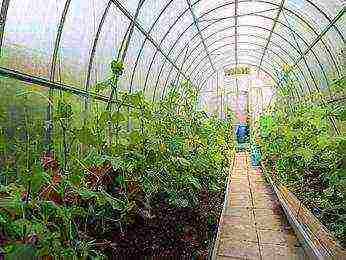
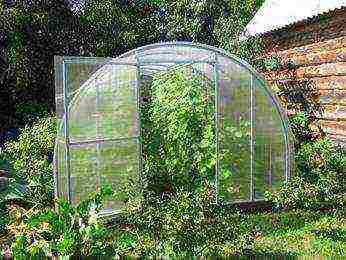
Seed selection
If you decide to grow cucumbers in a greenhouse, you need to choose the right seeds. Experts say that the best cucumber seeds for greenhouses are:
- Hybrids. You will have to purchase new seeds every year, since varietal traits are not transmitted. But on the other hand, hybrids are more resistant to diseases, give a bountiful harvest in any conditions.
- Self-pollinated cucumbers or varieties that do not need pollination. If you plant insect pollinated varieties, you will have to lure insects into the greenhouse, and this is a waste of time. It is better to purchase self-pollinated varieties that do not need insects for pollination. Or, alternatively, parthenocarpic. They do not require pollination at all; female flowers can set fruits themselves. Their distinctive feature is the absence of seeds.
- Early or medium ripening. When planting greenhouse cucumbers, we count on an early harvest, therefore, varieties must be selected either early ripening (40-45 days) or mid-ripening (45-50 days).
- Universal cucumbers that can be eaten and harvested for the winter.
What varieties can be planted
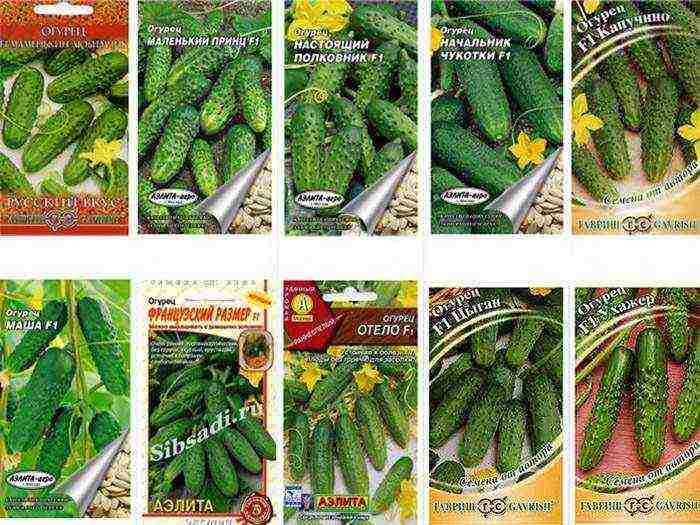
You can choose a variety yourself that would meet the above requirements. We will tell you about some of the most popular varieties among summer residents.
- Courage F1. This is an early maturing self-pollinated variety. It is resistant to many diseases, pleases with a rich harvest. The fruits can be used for canning and fresh, they are fragrant, crunchy, the average length is 14 cm.
- Connie F1. It is a mid-season, multi-purpose variety with good taste. Zelenets black-thorn, grows up to 9 cm, beam variety.
- Zozulya F1. This is one of the most famous varieties bred in the USSR. It has long fruits up to 30 cm. It belongs to mid-season varieties, resistant to many diseases. Its plus is a high yield, up to 45 kg per square meter. Minus is a salad variety, not suitable for salting.
- Tom Thumb. This is an early variety, yields a crop already on day 40, belongs to medium-fruited, is considered salting to varieties.
Greenhouse preparation
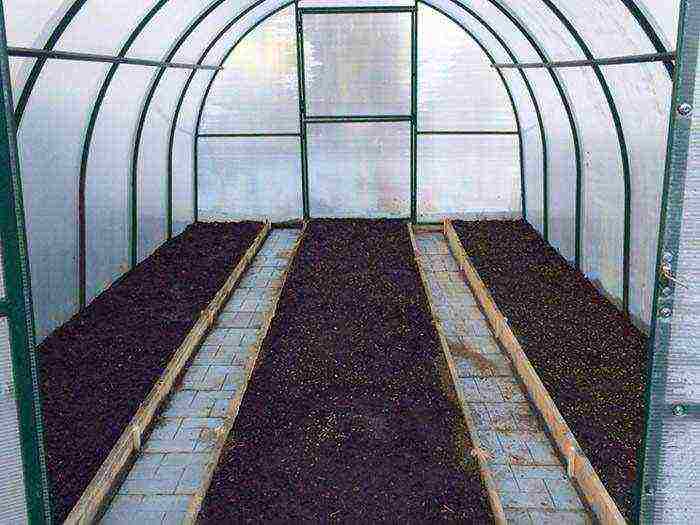
We will tell you in more detail how to properly grow cucumbers. To get a good harvest, you need to prepare the soil for planting cucumbers. It is better to renew the earth every 6 years. You can cook it yourself: mix turf soil with humus, add superphosphate (1 kg per sq. M) and potassium sulfate (500 g per sq. M), as well as a little ammonium nitrate. (100 g per sq. M). You can add some more peat or pine sawdust to loosen the soil. It is necessary to remove the top 20 cm of soil in the greenhouse and pour this mixture instead.
It is important to disinfect a greenhouse for cucumbers. How to do that? Prepare a 7% solution of copper sulfate and pour it over the ground, 0.5 liters per 1 sq. m. You can also use a solution of potassium permanganate, for its preparation in 10 liters of water, throw 3 g of powder. Even in the fall, the lower parts of the greenhouse must be wiped with a bleach solution.
It is important to fertilize the ground. 2-3 buckets of compost are introduced into the soil (it can be replaced with manure) per 1 sq. m, and also add 80 g of superphosphate, 30 g of urea, 30 g of potassium sulfate. The garden must be dug up. The bed is made with a height of 15 to 20 cm, its width should be 50-80 cm.
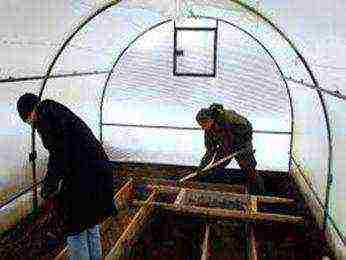
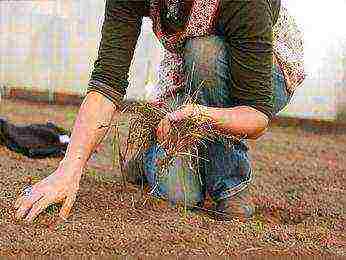
Landing
How to grow cucumbers in a greenhouse? How to plant and grow cucumbers in a greenhouse in the country? Planting cucumbers is done when the ground is already warmed up enough, that is, its temperature will be about 14-16 ° C. In the middle lane, they can be planted already in May, and for those who have warm greenhouses with two layers of film, warm beds have been built 1-2 weeks earlier. The main thing is that the temperature in the greenhouse is not lower than 16 degrees during the day and not less than 14 degrees at night, then the plants will be able to develop normally.
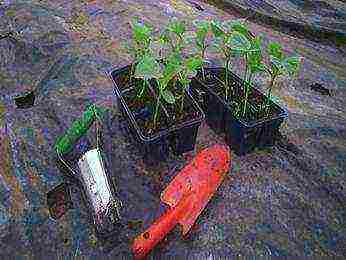
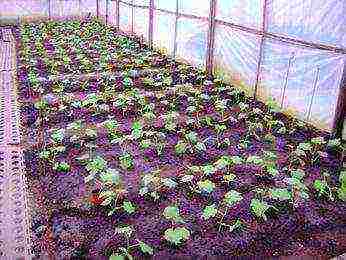
How to plant cucumbers correctly? It is impossible to thicken the planting, as in this case the risk of the appearance of various diseases of cucumbers increases. Therefore, the distance between the seedlings should be at least 40-50 cm, between the rows - 80-100 cm, that is, it turns out that 4 plants will fit on one square meter. If you want to harvest faster, you need to grow the seedlings in advance. But you can plant cucumber seeds in a greenhouse by putting 2 seeds in one hole.
How to land? Pour warm water into the finished hole and put a plant with a lump of earth right into the resulting mud. Cucumbers do not tolerate transplanting well, so the seedlings are grown in peat pots and planted with them.
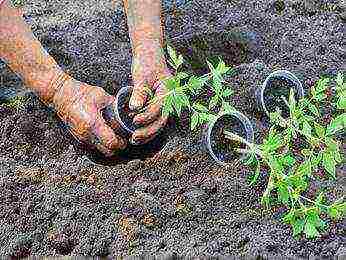
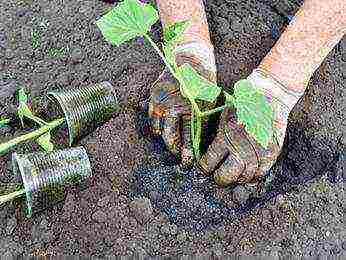
Care
Growing cucumbers in a greenhouse will require a lot of time and effort, but a rich harvest will be the best reward for all your efforts. Caring for cucumbers in a greenhouse is a garter, feeding, and watering. Plants need warmth, keep the temperature around 20 degrees during the day. If it is very hot outside, the greenhouse needs to be ventilated. Cucumbers love water, so they need to be watered often, at least once every 2 days, and on hot days - in the morning and evening.You need to use warm water (22-25 degrees), water the beds carefully, along the rows of cucumbers, trying not to damage the fragile roots.
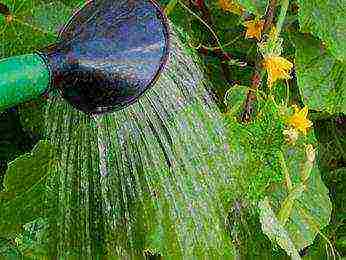
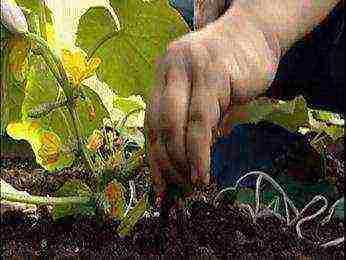
Top dressing
Feeding cucumbers in the greenhouse is also important. Top dressing is carried out every 2 weeks, after watering. You can use slurry, diluting 1 liter of infusion in 10 liters of water, or infusion of bird droppings - in 20 liters of water 1 liter of infusion. For 1 sq. m will take about 5 liters of water with fertilizer. You can dilute ash in water - for 10 liters 2 cups or use mineral fertilizers: 10-15 g of superphosphate and 3-8 g of potassium chloride per square meter. Fertilizers are applied at a distance of 7 cm from the plant, to a depth of 5 cm.
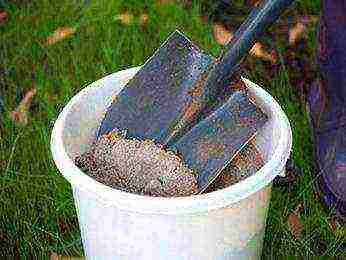

Formation
Over the cucumbers, you need to stretch the trellis wire, to which you need to tie a string. It is advisable to purchase a jute rope, since the plants do not really like synthetics. Already 2-3 days after planting, the stem is tied to a support. When the plants are slightly elongated, they will need to be wrapped around the rope. Then the vine itself will cling to the twine with antennae.

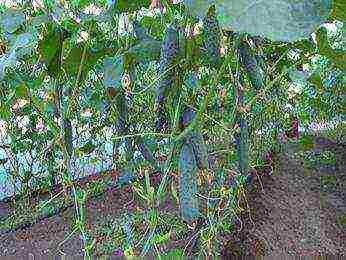
It is important to form the plant correctly. Count the 5 bottom true leaves. They need to be "blinded", that is, to remove flowers and stepsons from their bosoms. In the next 5 nodes, 1 fruit is left, then 5 more leaves are counted - in each of 2 fruits, then - 3 each. When the vine grows to the ceiling of the greenhouse, the main stem is neatly broken off.
You can listen to tips on plant formation from professionals in this video.
Planting and growing cucumbers in a greenhouse at your dacha is not such a difficult process. A novice gardener can also get a good harvest if he makes every effort. Time and effort will be well spent, as there is nothing tastier than aromatic, crispy cucumbers from your garden, which cannot be compared with stale shop cucumbers.
